Search: Womens Ball Off The Top From Lineout 1
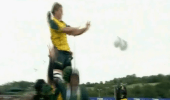
Women's - Ball off the top from lineout 1
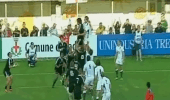
Junior - Ball off the top from lineout 1

Men's - Ball off the top from lineout 1
To watch over 2500+ videos join now for free!
JOIN NOW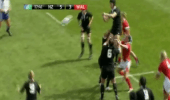
Women's - Ball off the top from lineout 2
 0:17
0:17
Junior - Ball off the top from lineout 2
Junior - Ball off the top from lineout 2
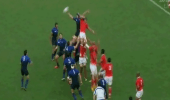
Men's - Ball off the top from lineout 2
An example of playing the ball from the top of a lineout
 0:39
0:39
Women's - Turnovers and move the ball 1
Women's - Turnovers and move the ball
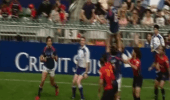
Sevens - Ball off the top from lineout
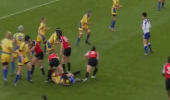
Women's - Patterns of Play 1
Three phases of play with accurate passing and quick ball from each breakdown creates the opportunity for the scrum half to run through and score Key factors Present a target with your hands Pass the ball laterally Run straight / inside shoulder of the defender
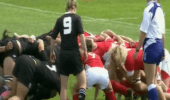 0:18
0:18
Women's - Straight Scrums 1
A well contested scrum from both teams. Good technique and body position ensure a solid and safe scrum. The red team use this restart to kick and gain territory. Key factors : Strong body position - Tight binding between the players - Calling - Players push in a straight line - Ball control from ther no 8
 0:04
0:04
Men's - Lineout maul good defence 1
Men's - Lineout maul good defence 1

Men's - Lineout catch & maul drive 1
Men's - Lineout catch & maul drive 1
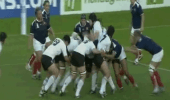 0:20
0:20
Women's - Lineout catch & maul / drive
Women's - Lineout catch & maul / drive
 0:21
0:21
Women's - Strike Moves 1
Women's - Strike Moves 1
 0:21
0:21
Women's - Exiting the 22m 1
Women's - Exiting the 22m 1
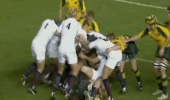 0:25
0:25
Women's - Lineout mail good defence
Women's - Lineout mail good defence
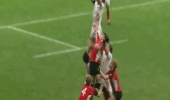 0:36
0:36
Sevens - Full Lineout 1
Sevens - Full Lineout 1
 0:22
0:22
Men's - Good body position in contact & ball presentation 1
Men's - Good body position in contact & ball presentation 1
 0:15
0:15
Women's - 2 v 3 1
Women's - 2 v 3 1
 0:17
0:17
Women's - Offloads 1
Women's - Offloads 1
 0:31
0:31
Women's - Good contact body position/ball presentation 1
Women's - Good contact body position/ball presentation 1

Women's - 2 v 1
Women's - 2 v 1
 1:03
1:03
Mike Catt - Attacking from Lineouts - Quick Ball
Classroom session with Mike Catt - discussing the key points of attacking from a lineout
Scrum Factory - 4. TOP Core Balls
The core ball provides a variety of challenges to the player in both body management and technical competence
Scrum Factory - 3. TOP With Rugby Balls
Expensive training equipment is not necessary and the simple rugby ball can provide an excellent technical and conditioning work out
 0:21
0:21
Men's - Turnover and move the ball 1
Men's - Turnover and move the ball
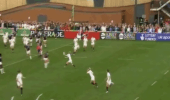 0:27
0:27
Women's - Counter attack plays 1
Women's - Counter attack plays
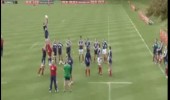 0:17
0:17
Lions 09 Lineout 1
The Lions practice their lineouts
 1:00
1:00
Mike Catt - Attacking from Lineouts - Back Ball
Classroom session with Mike Catt - discussing the key points of attacking from a lineout

Women's - Turnovers and move the ball 3
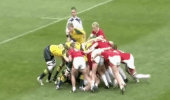
Women's - Collapsed Scrums 1
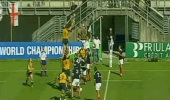
Junior - Full Lineout 1
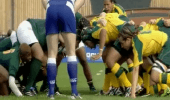
Women's - Wheeled Scrums 1

Women's - Turnovers and move the ball 2

Women's - Standard restart with attack winning ball

Men's - Short lineout 1

Sevens - Standard restart with attack winning ball 1
6. Support - Lineout Ball
Isolated technical practice
Courtesy of the SRU
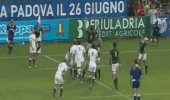
Junior - Short Lineout 1
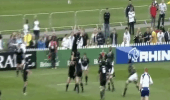
Women's - Short lineout

Junior - Standard restart with attack winning ball 1

Women's - Full lineout
Sevens - Turnovers and move the ball 1

Women's - Accurate clearing of players 1
 5:59
5:59
Lineout Throw with Dylan Hartley
Dylan Hartley explains his own approach and routines for throwing into the line out and provides some tips and advice to young players
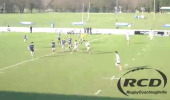 0:28
0:28
Strike move from Lineout
RGS Guildford secure lineout ball and perform a 'circle' ball, with the fly-half looping around the centre who pops the ball back to him. This is to draw in defenders, to create space out wide. The winger is able to exploit this space to complete the try.
The Lineout Game - Defence
Defending against the lineout throw is a key area for disrupting the opposition and their attacking platform. The defending jumper can be very effective by getting a hand in between the opponents’ hands and disrupting the catch. This may also block the vision of the opponent who wishes to follow the flight of the ball
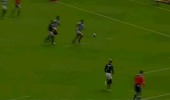
Sevens - 2 v 1
Seven's is about creating chances and then taking them. In this clip the Blue team take the ball up the middle of the pitch to draw in defenders, after recycling the ball they have a 2 v 1 opportunity, a straight line of running and a flat wide pass creates the try. Key factors : Call early - Run straight - Wide spin pass - Catch and swerve to score
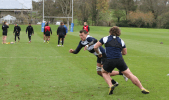 1:39
1:39
Bath - Create Quick Ball From Slow Ball
Quick ball is the platform to score tries from and one of the coaches tasks is to understand how to break defences down to create quick ball. Bath are famous for their attacking play and they are happy to share this technique and help others play fast rugby
 5:13
5:13
Ball Retention Techniques
Progressions are used to build the technical competency and the confidence of players learning to clear defenders away from the contact area. It is interesting to see that no contact shields are used
The Lineout Game - The floor game
The lineout competition is not won and lost when the ball is caught. If the team defending the throw cannot compete in the air, they can subsequently compete on the ground and disrupt the quality of possession the opposition wish to use
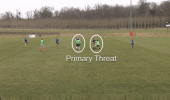
Defence - 1. Primary Threat
If the ball is tucked under one arm, the ball carrier is unlikely to throw a 10 metre miss pass. So are the attackers 2 and 3 places out the primary threat?
If the ball carrier is running with the ball in both hands, the immediate threat may have a wider radius
If two centres are running at a centre and a prop, the primary threat may be the space defended by the prop
The Lineout Game - Under14
Players begin to use movement with the intention of deceiving the opposition as to where the ball will be thrown. However if the ball is always thrown to the front, how effective will this movement be?
This clip illustrates how the front ball is secured by jumping and catching skill and then protected by the support players. If the same skills could be used with a middle ball, the tactical decision making will also be developed
How many coaches opt for safety and not for the long term development of their players?
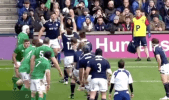 3:48
3:48
Scotland New Lineout Move
Scotlands clever score from the line out v Ireland was a great example of coaches or players being innovative and looking at new ways to do things. This clip shows a few slightly different uses for placing your scrum half at the front of the line out. It is just ideas and about pushing the boundaries of the laws
Step 6 - Introducing the Lineout
 0:54
0:54
Women's - Wrap Tackle
Women's - Wrap Tackle
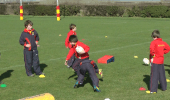 2:24
2:24
1 v 1 Tackling in Channel
An opportunity for players to put what they have learnt on tackle technique into practice. Each tackle is observed by all other players who can give feedback. Ensure all players have a go at attacking and defending.
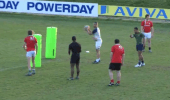 0:44
0:44
Learning to spin pass 1
Stand side-on to progress towards the lateral pass. Push the ball rather than swinging so your hand is pointing to the target after the ball has been passed. Maintain soft hands when catching the ball
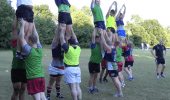 6:20
6:20
Lineout Lifting Fundamentals - Get started
An effective line out is based upon the fundamentals of movement, jumping and lifting. James Cannon from London Wasps takes some amateur players through the basic skills and techniques
Step 3 - Introducing the 1 v 1 Scrum
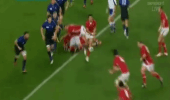 0:30
0:30
Men's - Patterns of play 1
Three phases of play with accurate passing and quick ball from each breakdown creates the opportunity for the scrum half to run through and score
Key factors : Present a target with your hands - Pass the ball laterally - Run straight / inside shoulder of the defender
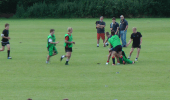 1:27
1:27
Turnover session - 1 Game to start
A full contact game, conditioned with channels on either side of the pitch. The attacking team must get the ball to both channels before they are allowed to score a try.
This is to spread the attack out, and create more opportunities for turnover ball to occur.
NB - Please ensure players have completed a full upper body warm-up before going into this full contact session.
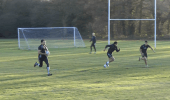 0:49
0:49
Broncos 1 - Scramble defence - Tracking back
Use this exercise to replicate a line break with one defender to beat. The attackers need to move the defender and execute a 2 v 1 while the initial defender tracks back to stop the pass. Also works movement at top end speed for the main attacker
 0:20
0:20
Sevens - Straight Scrums 1
A strong scrum from the black team turns over the ball for an attack. The left hand prop (Loose head) puts pressure on the Red team hooker so that he does not hook the ball effectively. Key factors : Tight binding - Low driving position - Working as a unit - Leg drive
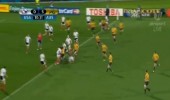 0:17
0:17
Men's - 2 v 1
A good example of phase play to create a 2 v 1 attacking platform. The initial deep pass then creates an overlap and the defender drifts to allow the attacker to run through easily.
Key factors : Quick ball at breakdown - Straight lines of running - Deep pass - straight lines of running again - Loud communication
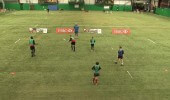 0:28
0:28
3 v 1 in Channel
A progression from the 2 v 1, where a second pass is encouraged to move the ball away from the defender.
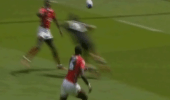
Sevens - 2 v 1
A variety of passes create a 2 v 1 which is executed perfectly for the outside attacker to score. Key factors : Different angles of running and support - Comunication - Ball presentation - Effective clearing of defenders at the breakdown - Accurate wide passes - Attack the inside shoulder of the last defender - Flat spin pass
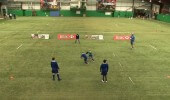 0:38
0:38
1 v 1 Evasion Skills
A lone attacker must beat a single defender. This is great way to develop evasion skills in the attacker, and positioning for the defender.
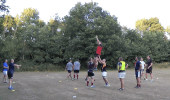 6:08
6:08
Lineout Lifting Progressions
The second session focusses on developing the basic techniques for building your line out. Wasps second row James Cannon takes some level 6 players through some progressions
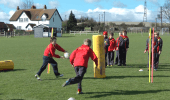 1:02
1:02
Passing - 2 v 1 Static Defender
Now working in just twos, we are concerned with depth, and the timing of the pass. Allow players to practice before adding a static defender. This can be a tackle bag as demonstrated. Players take the ball up to the defender but must complete the pass before they reach it.
 3:41
3:41
Kicking - The Drop / Ball Placement
Dropping the ball properly is considered the main priority for many kickers, if they get the drop right then the other techniques fall into place. Dave Walder from the Newcastle Falcons explains some of the skills
Tag Game - Tag Rugby 1
Tag Game - Tag Rugby 1
 1:09
1:09
Lineout Throwing with Dylan Hartley
Northampton Saints and England hooker Dylan Hartley talks through his lineout throwing procedures and explains the importance of routine
 4:08
4:08
Grip Games - Ball Retention
This great game helps you work on your ball transfer and fend. It teaches players how to keep the ball away from contact increasing ball retention on the pitch!
 1:55
1:55
Lineout essentials
The lineout provides an essential attacking platform. Log in to see advice and examples from pro players, suitable for elite, adult and youth players.
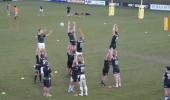 0:47
0:47
Lineout - 4 pod passing challenge
Four lifting pods must hold their jumpers aloft long enough for them to pass a ball through the hands twice. Lifters should stand close together and try to lock-out their arms. Jumpers should maintain a strong core and keep their legs straight to make life easier for the lifters.
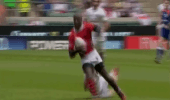 0:37
0:37
Sevens - Classic Tackle 1
Good tackle technique when chasing a player from behind. The defender gets to his feet quickly to contest the ball. Key factors : Head to one side - Arms around attackers waist and slide down - Keep your arms around the attackers legs - Use momentum to get back to your feet
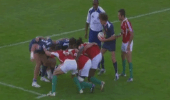 0:31
0:31
Sevens - Wheeled Scrums 1
A strong scrum can be a great weapon for attack in seven's, in this clip the Red scrum puts pressure on the defending loose head (Right hand prop) which wheels the scrum and allows the defending scrum half to disrupt the ball forcing a turnover. Key factors : Tight binding - Low body position - Leg drive - Working as a unit
The Lineout Game - Offloading
The ball should ideally be taken early and delivered with firm, but sympathetic direction. The arms and legs of the jumper will be ideally close together throughout the jump in order to maintain good core stability. Keeping the legs together will also assist the front lifter to remain stable. If the jumper does not control their legs, the front lifter cannot control the lift and support
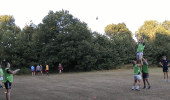 6:01
6:01
Lineout Pods and Movement
The coach progresses the line out onto small units working together, adds in some competition and starts work with some five man options
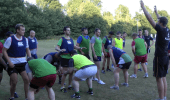 4:41
4:41
Learning to Lift for the Lineout - Get started
Some slightly different progressions in building upon the basic skills for an effective line out
The Lineout Game - Senior
“The line out principle is to catch the ball in a space where no-one else is.”
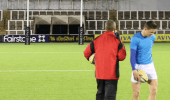 1:53
1:53
Kicking - Striking The Ball
Accurate kicking requires an understanding of how the foot should strike the ball. Expert kicking coach Dave Walder delivers a coaching clinic detailing the key factors and steps coaches should follow
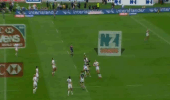 0:28
0:28
Sevens - Standard restart with attack winning ball 3
A well organised re start with one main attacker challenging for the ball with support both in front and behind him, if the ball is knocked either side of the main catcher the ball will be gathered by his teammates. Great leg drive to continue the attack and a very long pass to complete the scoring. Key factors : Accurate kick - Focus on the ball - Sideways jump - Catch ball above head - Structured support
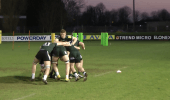 1:40
1:40
Lineout Catch-and-drive
Lineout catch and drive drill
 2:13
2:13
Lineout Tips from London Irish Forwards
London Irish forwards talk through some of the elements that make an effective lineout, and how you can prepare for a match.
Step 2 - Introducing Competition for the Ball
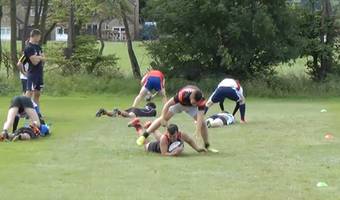 3:26
3:26
Quick Ball Presentation Drills
Use these quick and competitive games to practice good and strong ball presentation. Practice with high standards and it will come naturally in the games!
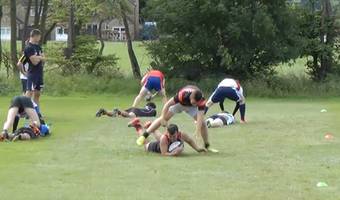 3:26
3:26
Quick Ball Presentation Drills
Use these quick and competitive games to practice good and strong ball presentation. Practice with high standards and it will come naturally in the games!
Dylan Hartley on the Lineout
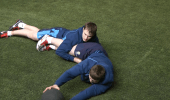 2:30
2:30
Worcester Academy - Ball Presentation
Worcester Academy - Ball Presentation
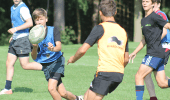 3:57
3:57
More Time on the Ball
Good players have more time on the ball? What they do do is prepare accurately with depth, width and run good lines. This sets them up to catch & pass with time and options. The practises in this clip outline some of the disciplines required to get you "More time"
 2:51
2:51
London Irish - Using Round Balls
Adding variety into your sessions keeps players interested as they learn new skills or try to improve key techniques but in a different way. Patrick O'Grady from London Irish explain why he uses different sized balls
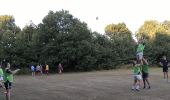 1:50
1:50
Lineout Lifting Basics
The lineout is a key part of rugby union and it is vital for player safety and success that the proper technique is learnt. James Cannon of London Wasps walks through the key technical elements of lineout lifting and jumping. Log in to see the full session.
 2:07
2:07
Don't Forget the Ball - Conor O'Shea
Early season conditioning doesn't need to be boring. Get the ball in hand and get fit (and improve skills) by using games! There are loads of great conditioned game ideas on PremiershipRugbyCoaching.com
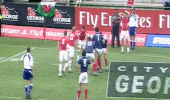 0:38
0:38
Sevens - Full Lineout 3
Accurate skills are the key to lineouts in seven's, a combination of movement, lifting and throw combine to make an effective restart for the attacking team. The shape of the attacking side is pre planned to create a mis - match with a faster player v a slower one. key factors : Pre call the move - Fast feet - Strong core for jumper - Support from both players to lift the jumper - Jumper to jump - Accurate throw - Support he jumper to the ground - Offload pass to scrum half
 1:18
1:18
Lineout Fundamentals
Dominant lineout players such as Geoff Parling build their trade on solid technical foundations. Log in to RCD for plenty of coaching tips on lineout technique.
 1:15
1:15
Geoff Parling - Lineout Dominance
Dominant lineout players such as Geoff Parling build their trade on solid technical foundations. Log in to RCD for plenty of coaching tips on lineout technique.
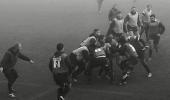 1:02
1:02
Lineout Catch & Drive
Premiership Rugby coaches and players highlight the importance of the lineout as an entry point and an attacking platform. Join PremiershipRugbyCoaching.com for ideas and examples to improve your lineouts.
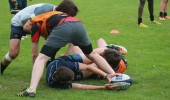 2:10
2:10
Ground Work and Ball Presentation
It is important for players to practice working hard on the ground to get the ball presented back to their team. This session uses bodyweight exercises to practice the movement and enforces it with a conditioned game. Log in to see the full video.

